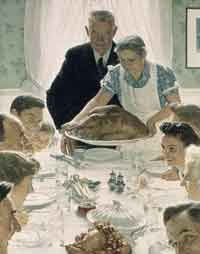An Antique Thanksgiving
The earliest classification or style of American Furniture is popularly known as the "Pilgrim Period"(1640 -1690). European trained woodworkers, mostly from England, modeled their furniture after medieval and Renaissance design. It was massive, rectilinear and sturdy. "Joiners" used mortise-and-tenon joints and inset panels to fashion thick slabs of their preferred woods, oak and pine, into bible boxes, blanket and linen storing chests-which also served as chairs, cupboards, paneled cradles, trestle base and gateleg tables.

flowers, lunettes, scrolls, leafage, and geometric elements. "Turners," cut lathe-turned posts and spindles, and assembled those elements into "joint stools" and massive chairs called "Great" chairs. Large armchairs called "Carve
r chairs," and complex "Brewster chairs," are named after men who supposedly took such thrones with them on Mayflower.
Coveted by museums and collectors today, examples can be viewed at major museums including Plimoth Plantation in Plymouth, Massachusetts. Besides two chairs, the brave religious/political revolutionaries who landed at Plymouth Rock, December 21, 1620, had little in the way of furnishings. No pre-1640 American furniture specimens have been found extant.Some crude tables must have been hacked out however, because a year after they landed, a three day feast including ninety "Indians," now referred to as the "first Thanksgiving," did take place. Two accounts were made. One was by Governor William Bradford(1590-1657) in his important chronicle called the "History of Plimouth Plantation(until 1646)." The second was scribed by a colony leader, Edward Winslow, in a journal known as "Mourt's Relation." Documents of this type are the greatest of all antiques. They are windows to the beginning of all wisdom-the past. Here is an excerpt from Winslow's journal:
"Our harvest being gotten in, our governor sent four men on fowling, that so we might after a special manner rejoice together after we had gathered the fruit of our labors. They four in one day killed as much fowl as, with a little help beside, served the company almost a week. At which time, amongst other recreations, we exercised our arms, Many Indians coming amongst us, and among the rest their greatest King Massasoit, with some ninety men, whom for three days we entertained and feasted, and they went out and killed five deer, which they brought to the plantation and bestowed on our governor, and upon the captain and others. And although it be not always so plentiful as it was this time with us, yet by the goodness of God, we are so far from want that we often wish you partakers of our plenty."
Clearly Wampanoag Indians, part of the Algonkian-speaking peoples, and the Pilgrims did give thanks to their own same God(s) following that first harvest. Understanding their plight at the time is a lesson toward understanding the true meaning of today's holiday. The Wampanaog's had encountered European explorers, fishermen and slavers before. They knew something of their power and probably foresaw the white men's weapons and plagues as a threat to their way of life. Still, "Tisquantum" or "Squanto" (one of the heroes of today's Thanksgiving tales) and his fellow tribespeople did help newcomers survive by teaching them to cultivate corn and build Indian style houses.
Sadly, a terrible plague of small pox would all but wipe out these benefactors a year later. As for the Pilgrims, they had just suffered a year where they had buried half their number, leveling graves and sowing them with grain in the spring to conceal their losses from the Indians. Still, in 1621 the two races sat together for a short-lived peace and gave thanks for their blessings. That is the true meaning of Thanksgiving, Charlie Brown!

